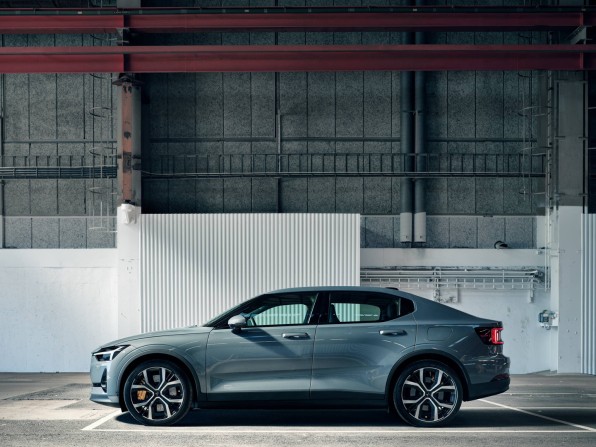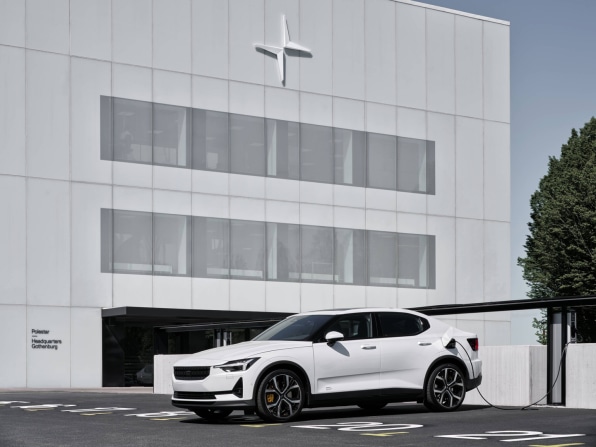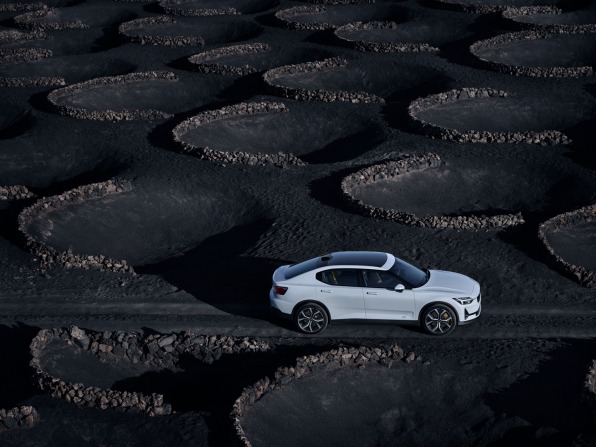I approach the green light hoping, perhaps for the first time in my life, that it turns red before I reach the intersection. When it does, I steel myself, facing an open road with no one in front of me. Underneath my foot? A pedal attached to 408 horsepower of silky electric motors that will launch me from 0 to 60 miles per hour in 4 seconds flat. It’s an addictive sensation that feels less like a machine is moving me than that I’m moving the machine through sheer will.
Not bad, for a car built out of water bottles and old fishing nets.

Spun out of Volvo’s skunkworks lab by designer-CEO Thomas Ingenlath, Polestar is a performance-oriented Swedish car brand that balances luxury with sustainability. The electric drivetrain offers blistering fast speeds off the line. (The Polestar 2 would lose a quarter mile race to Dom’s Charger, but beat Elon’s base Model 3.) However, its unique appeal is based upon nearly every other detail. In my week with the car, I’m surprised how many people stop me to ask what I am driving, while admiring the car’s forward posture, giant tires, and high tailgate that perpetually threatens to pounce. On the road, I feel like a Scandinavian businessman who could be grabbing some Kanelbulle from the local bakery, or pulling up at my competitor’s office to execute a hostile takeover.

Instead Polestar has been rewriting the idea of luxury altogether, as an environmentally conscious, high-touch experience. The company announced plans to produce a carbon-neutral car by 2030, and the Polestar 2 is something of an early prototype to what that vehicle might look like. It goes so far as to use blockchain technology to trace the cobalt used in its batteries. Cobalt is often sourced via unethical mining practices, and the provenance can be fudged over the course of delivery. “Through these measures, we can state unequivocally that our cobalt is sourced responsibly,” the company writes.
Nothing about the interior reads earthy-crunchy, but that’s exactly what it is. In the fully vegan interior, the seats, for instance, hug your back like a premium performance vehicle, yet the cloth is a specially woven material made from water bottles. Likewise, the carpeting in the floor is created from fish nets. The black ash on the dashboard is treated to look dark gray so that it eliminates blemishes in the wood, thereby allowing more of the wood to make its way into the vehicle and out of the waste pile.

That exploration of material translates all the way to the vehicle’s sound design. Speed freaks will fall in love with the subtle electronic whir as you accelerate, the soundtrack of a 1980s sci-fi movie filtered by Swedish restraint. My favorite audio moment is in using the turn signal. The sound is a subtle, plasticky pop that never grates on your ears. And like the rest of the interior, it’s the unapologetic culmination of industrial processing. That sound is a purely electronic invention in service of creating a new experience for the driver.
Yet most of the experience of driving a Polestar isn’t foreign at all. Whereas the UX of a Tesla is built upon unintuitive gestures—you have to hit a button to lower the window before opening the Model 3 car door, and you engage Autopilot by pulling down on the gear shift twice—all of the touch points inside the Polestar are like those of any nice car. “The car feels quite logical or intellectual. You understand it,” says Missoni. “There’s not much styling going on. It’s not highly emotional; that’s an excuse for doing something random.”
Within the vehicle’s software, a few well-labeled options do let you go deeper to customize the feel of driving, by changing the responsiveness of the steering and how aggressively the car automatically slows itself to regenerate energy when your foot is off the pedal. (If you want, and you’re willing to give up some range, you can make the Polestar 2 drive almost just like a gas car, to soften the transition to electric.)
But as I sit at the light, I don’t think about any of this. My fingers grip the wheel. The light turns green. I slam the pedal. And I fly, before a road sign rendered on the dash blinks 35 mph, and I realize that the hostile takeover can wait. For now, I really do need to slow down.
See more from Fast Company’s 2021 Innovation by Design Awards. Our new book, Fast Company Innovation by Design: Creative Ideas That Transform the Way We Live and Work (Abrams, 2021), is on sale now.
"exciting" - Google News
September 21, 2021 at 05:15PM
https://ift.tt/3tZFfrP
Polestar 2: Test-driving this exciting Tesla competitor - Fast Company
"exciting" - Google News
https://ift.tt/2GLT7hy
Shoes Man Tutorial
Pos News Update
Meme Update
Korean Entertainment News
Japan News Update
Bagikan Berita Ini















0 Response to "Polestar 2: Test-driving this exciting Tesla competitor - Fast Company"
Post a Comment